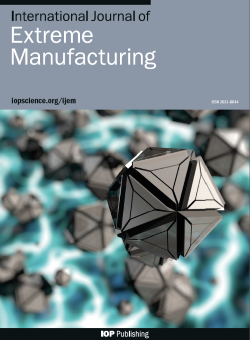A novel approach of jet polishing for interior surface of small grooved components using three developed setups
IF 16.1
1区 工程技术
Q1 ENGINEERING, MANUFACTURING
引用次数: 0
Abstract
It is a challenge to polish the interior surface of an additively manufactured component with complex structures and groove sizes less than 1 mm. Traditional polishing methods are disabled to polish the component, meanwhile keeping the structure intact. To overcome this challenge, small grooved components made of aluminum alloy with sizes less than 1 mm were fabricated by a custom-made printer. A novel approach of multi-phase jet polishing is proposed using a developed polisher, consisting of solid, liquid and gas phases. In comparison, an abrasive air jet polishing is suggested through a customized polisher, including solid and gas phases. After jet polishing, surface roughness (Sa) on the interior surface of grooves decreases from pristine 8.596 to 0.701 and 0.336 μm by abrasive air jet polishing and multi-phase jet polishing, respectively, and Sa reduces 92% and 96%, correspondingly. A formula is given out for the relationship between linear energy density and unit defect volume. The optimized parameters in additive manufacturing are that linear energy density varies from 0.135 to 0.22 J∙mm-1. Defect volume of unit area achieved by optimized parameters lessens 1/12 that of non-optimized ones. Computational fluid dynamics simulation reveals that material is removed by shear stress, and the alumina abrasives experience multiple collisions with the defects on the heat pipe groove, resulting in uniform material removal. This is in good agreement with the experimental results. The novel proposed setups, approach and findings provide new insights to manufacture complex-structured components, polish the small grooved structure, and keep it unbroken.使用三种已开发设置对小型凹槽部件内表面进行喷射抛光的新方法
对结构复杂、沟槽尺寸小于 1 毫米的快速成型部件的内表面进行抛光是一项挑战。传统的抛光方法无法在抛光组件的同时保持结构的完整。为了克服这一难题,我们使用定制打印机制造了尺寸小于 1 毫米的铝合金小凹槽部件。我们提出了一种新颖的多相喷射抛光方法,使用开发的抛光机,由固相、液相和气相组成。相比之下,建议通过定制的抛光机(包括固相和气相)进行磨料空气喷射抛光。经过喷射抛光后,凹槽内表面的表面粗糙度(Sa)从原始的 8.596 微米分别降低到 0.701 微米和 0.336 微米,其中磨料空气喷射抛光和多相喷射抛光的 Sa 分别降低了 92% 和 96%。给出了线性能量密度与单位缺陷体积之间的关系式。增材制造的优化参数为线性能量密度从 0.135 到 0.22 J∙mm-1 不等。优化参数实现的单位面积缺陷体积是未优化参数的 1/12。计算流体动力学模拟显示,材料是通过剪切应力去除的,氧化铝磨料与热管沟槽上的缺陷发生多次碰撞,从而均匀地去除材料。这与实验结果十分吻合。新提出的设置、方法和研究结果为制造复杂结构部件、抛光小凹槽结构并保持其无破损提供了新的见解。
本文章由计算机程序翻译,如有差异,请以英文原文为准。
求助全文
约1分钟内获得全文
求助全文
来源期刊

International Journal of Extreme Manufacturing
Engineering-Industrial and Manufacturing Engineering
CiteScore
17.70
自引率
6.10%
发文量
83
审稿时长
12 weeks
期刊介绍:
The International Journal of Extreme Manufacturing (IJEM) focuses on publishing original articles and reviews related to the science and technology of manufacturing functional devices and systems with extreme dimensions and/or extreme functionalities. The journal covers a wide range of topics, from fundamental science to cutting-edge technologies that push the boundaries of currently known theories, methods, scales, environments, and performance. Extreme manufacturing encompasses various aspects such as manufacturing with extremely high energy density, ultrahigh precision, extremely small spatial and temporal scales, extremely intensive fields, and giant systems with extreme complexity and several factors. It encompasses multiple disciplines, including machinery, materials, optics, physics, chemistry, mechanics, and mathematics. The journal is interested in theories, processes, metrology, characterization, equipment, conditions, and system integration in extreme manufacturing. Additionally, it covers materials, structures, and devices with extreme functionalities.
 求助内容:
求助内容: 应助结果提醒方式:
应助结果提醒方式:


